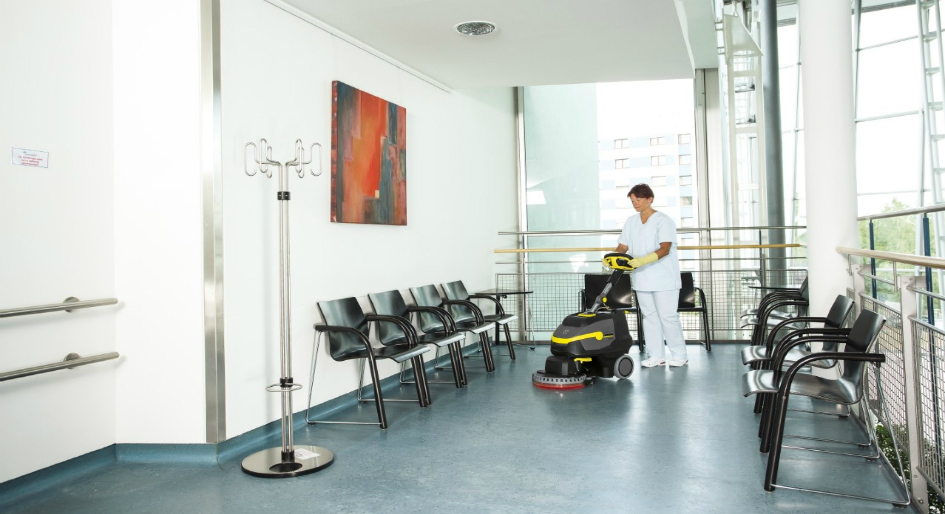Cleaning surfaces in healthcare environments, such as hospitals, long term care (LTC) and assisted-living facilities, presents a unique challenge not found in other buildings due to the presence of pathogens and soils that require a higher cleaning protocol, especially in hard to access areas like floor corners.
Traditional methods, such as wet mopping, are largely ineffective at removing soils in corners; the mopping moves soiled water across the surface, depositing the bacteria-laden water back into the corners where it dries.
New methods, materials and equipment are entering the healthcare market every month, often without much science to back up their efficacy claims. As a result, users should always consider using a systems-based approach that examines cleaning efficiency, how the process fits within the guidelines of infection prevention and control and how new methods and equipment impact labour. The adoption of a systems-based approach to cleaning floors and corners is a suggested best practice.
Some common areas in facilities that harbour potentially harmful bacteria and soils include the back wall behind toilets and urinals in washrooms, behind equipment in medical treatment rooms and in surgical suites, patient and resident rooms.
Washroom corners
Cleaning a washroom is often challenging because it’s a confined area. Full-size scrubbers will not easily clean corners in washrooms due to their size and mobility. As mentioned earlier, mops simply move soil and pathogens around, without actually removing them. To deodorize, lift soils and kill pathogens, the use of steamers has proven very effective; steam vapors penetrate hard-to-access corners and the resident soils. The heat destroys the bond between contaminants, soils and the surface while also destroying bacteria, viruses, odours and fungi.
Clostridium difficile is one of the most serious pathogens found in washrooms, Because C. difficile is shed in feces, any surface (toilets, for example) that becomes contaminated may serve as a reservoir for the C. difficile spores. C. difficile can live for long periods on surfaces, and the recent emergence of more resistant and virulent C. difficile strains, coupled with the inability of many liquid chemical disinfectants to kill C. difficile spores, has highlighted the need for new surface disinfection technologies, and steamers are an excellent tool.
Medical treatment rooms
Medical treatment rooms typically have equipment and furniture that inhibits access to corners. For effective cleaning, use a vacuum with attachments that will reach under, over and around equipment and furnishings. The removal of loose dust and soils will help to prevent buildup. Follow with a bi-weekly or monthly project cleaning schedule that involves moving equipment and furnishings to deep clean this area.
Surgical suites
Surgical suites require a rigorous floor cleaning procedure that addresses all areas, especially the corners. To start, flood floors and corners with the disinfectant solution and then machine scrub them. Move equipment away and scrub into each corner as closely as possible. After allowing the chemical to dwell for the time prescribed by the manufacturer and IPAC guidelines, vacuum floors and corners thoroughly using a wet/dry vacuum to remove any remaining cleaning solution.
Patient rooms
Hospital patient rooms often have cleaning challenges due to the immobility of beds with patients in them. The common procedures of a “terminal clean” help to resolve this challenge effectively. When a patient is discharged, deep clean the room and floors by moving all equipment and furniture to the hallway or opposite side of the room. Liberally apply the floor solution into corners and crevices with a mop or compact auto scrubber. Allow the chemical to dwell and then remove. Generally, high touch surfaces are a higher priority when cleaning patient rooms, and a patient room clean will take approximately 25 minutes. Time is dependent on the number of tasks and the process used to perform each task in an effective manner.
Resident rooms in long-term care facilities
Cleaning a resident room in long-term care and assisted living is similar to the process above. While LTC rooms are typically cleaned every day, it is less likely that furniture and equipment will be shuffled around in order to clean corners. In order to maintain optimal cleanliness, utilize a scheduled project cleaning process to allow for periodic deep cleaning of corners. However, take caution here; in the event of influenza and Norovirus outbreaks, you must have and follow an outbreak cleaning protocol.
Steven Hughes is the Western Canada Strategic Accounts Manager for Kärcher Canada. Steven works to support the equipment and cleaning process needs of a diverse range of industries. He combines Kärcher’s rapidly developing technology and his knowledge of industry practices to help promote the cleaning industry’s continued growth and improvement. Steven has extensive experience as a consultant, speaker and trainer in the healthcare cleaning industry and is a published author on public speaking and presentation skills.










